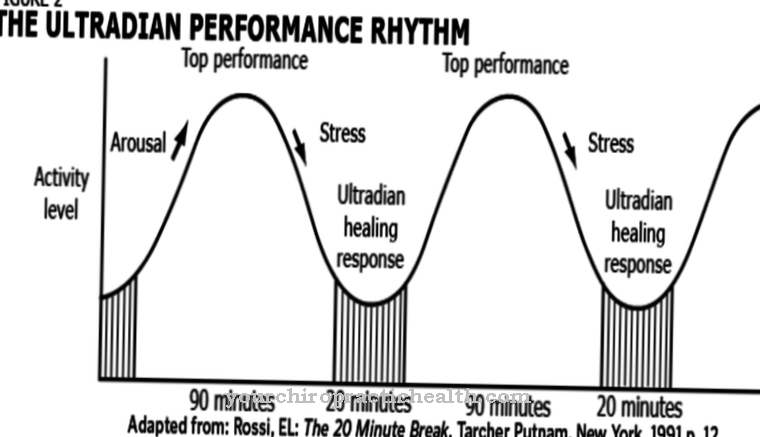At the Stretch-shortening cycle (DVZ) an eccentric stretching of a muscle is followed by a concentric contraction of the same muscle, which is energy-saving and uses the kinetic energy from the stretching. The DVZ plays an important role in reactive movements and is triggered by the flexibility of the muscles and the stretch reflex. Disorders of the cycle appear in the context of the extrapyramidal syndrome.
What is the stretch-shortening cycle?

The stretch-shortening cycle is a mode of operation of the neuromuscular system. The activated muscle is initially stretched against its working direction, which is also known as eccentric muscle work. The eccentric work is followed by an automatic shortening of the stretched muscle, which is known as the concentric working method.
The stretch-shorten cycle can be fast or slow. The fast cycle takes place, for example, as part of sports movements. Since the muscles have plastic and elastic properties, contractions automatically and immediately follow an expansion. This means that eccentric muscle work must be followed immediately by concentric muscle work.
The contraction of the muscles takes place long before the muscle adapts to the stretch. The stretch-shortening cycle uses the stored energy from the stretching movement and makes concentric work particularly energy-saving and fast. In this way a particularly large development of force is achieved.
The cycle is primarily dependent on the flexibility of the tendons and ligaments. The contraction is triggered within the stretch-shortening cycle by the muscle spindle, which initiates the stretch reflex in the form of a motor response to the stretching stimulus.
Function & task
Before the start of a stretch, a muscle is pre-activated in the sense of pre-innervation. This creates a so-called Short Range Elastic Stiffness (SRES). This stiffness enables the muscle to resist stretching for a short time. The short range elastic stiffness is mainly due to the actin-myosin bridges of the muscle, which offer short-term resistance to stretching. The resistance of the bridges decreases due to the so-called bridge strain as the expansion continues.
When stretching, the muscle is also activated at the level of the stretch reflex. This increases the force of contraction because there is an additional cross-bridge formation. The contractile parts of the muscle, i.e. actin and myosin, increase the stiffness. In addition, the tendons of the muscle are elongated due to stretching.
The so-called stretch reflex is an intrinsic reflex that causes a muscle to contract when it is stretched and thus adjusts the length of the muscle. Like every reflex, the stretch reflex begins with a stimulus, in this case the stretch stimulus, which is detected by the muscle spindles. The muscle spindles are sensory cells of deep sensitivity and are connected to the central nervous system via afferent nerve tracts. The excitation is switched over to efferent motor nerve pathways that initiate the contraction of the muscle. In this way, an eccentric stretch in the human body is answered with a concentric muscle contraction.
The kinetic energy from the stretch is now used for the contraction. While many sources speak of the storage of kinetic energy in the connective tissue, just as many assume that it is stored in the tendons. The tendon is approximately ideally elastic and should be able to store kinetic energy due to this property. The kinetic energy arises in the eccentric phase of the movement and is now released again. The stretch-shortening cycle thus has a strength-enhancing effect compared to purely concentric muscle work.
The power of the stretching-shortening cycle cannot be achieved through purely voluntary muscle work. To trigger the cycle, the tendons must be stretched to the maximum. Only at maximum stretch does the body fear a tendon rupture and initiate the contraction to protect itself. A high degree of extensibility thus leads to an elongation-shortening cycle that is more difficult to trigger.
Illnesses & ailments
The stretching-shortening cycle is particularly important for the reactive force. This means the force needed to perform reactive movements, which differs from spontaneous force. The reactive force, and thus also the stretch-shortening cycle, can be promoted by means of plyometric training.
The stretch-shortening cycle can differ from person to person to a certain extent and depends, for example, on the level of training. Differences in the cycle do not have to be due to an illness. However, any neuromuscular disease can negatively affect the stretch-shortening cycle.
For example, reactive strength is limited after sports injuries. In plyometry, the stretch reflex is promoted by physiotherapy after injuries of this type.
In addition to sports injuries, a weakened reflex ability can indicate neuropathies. These are diseases of the peripheral nervous system that have no traumatic cause.
In addition, all reactive movements are disturbed in the hypokinetic-rigid variant of the extrapyramidal syndrome. Disturbances of the extrapyramidal system in the central nervous system become noticeable, for example, in the context of Parkinson's disease, chorea or ballism.
In addition, drugs such as neuroleptics influence the extrapyramidal motor system. In addition to ataxias, tremors or inhibitions to start, the tendency to fall is a typical symptom of the syndrome. The extrapyramidal system is a neuroanatomical structure in which superordinate motor control processes take place. Not all motor control processes are therefore in the pyramidal trajectory of the pyramidal system. All controls outside the pyramid system are summarized as activities of the extrapyramidal system, for example the stretch reflex as part of the stretch-shortening cycle.
In this context, all lesions of the extrapyramidal system can affect the stretch-shortening cycle. This applies to both bacterial and autoimmunological inflammatory as well as tumor-related, degenerative, traumatic and infarct-related damage to the neurological structure.



























